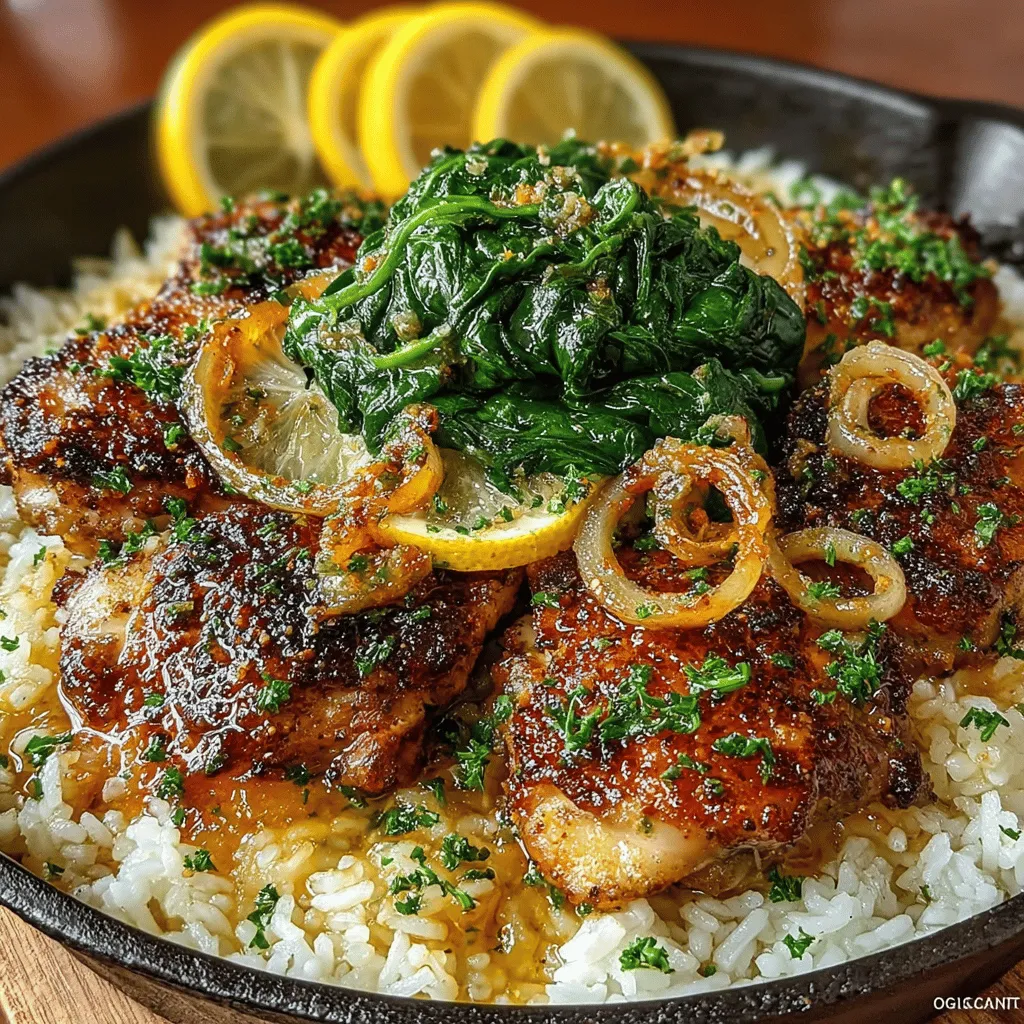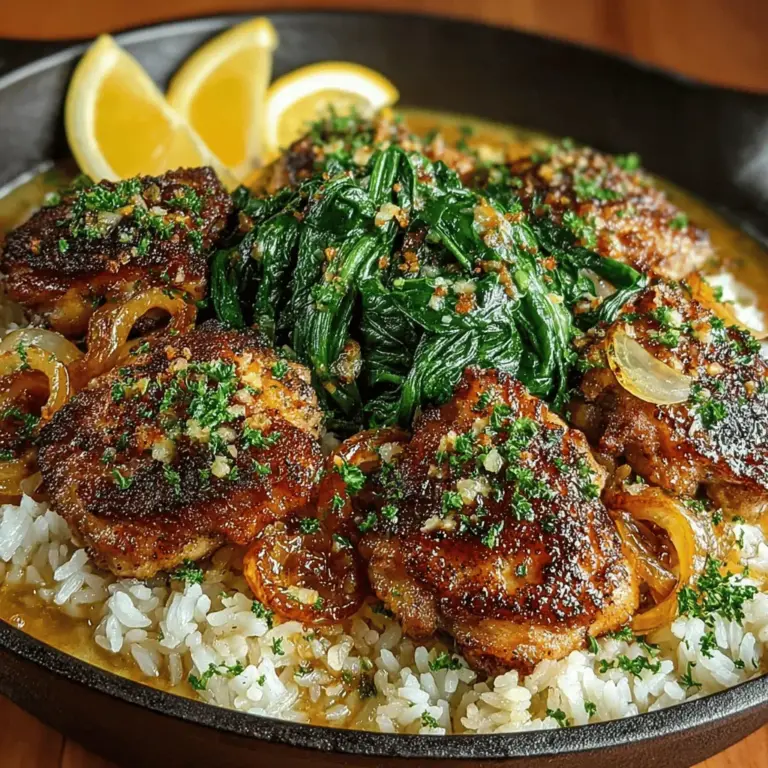Honey Dijon Chicken & Rice Skillet: A Flavorful One-Pan Delight
When it comes to quick and satisfying meals, few dishes can rival the versatility and deliciousness of a Honey Dijon Chicken & Rice Skillet. This dish combines tender, succulent chicken thighs with the sweet and tangy notes of honey and Dijon mustard, all harmoniously cooked with fluffy rice and fresh vegetables. Not only is it a treat for the taste buds, but it also embodies the essence of comfort food — perfect for busy weeknights or leisurely family gatherings.
The Appeal of One-Pan Meals: Convenience and Flavor
One-pan meals like this Honey Dijon Chicken & Rice Skillet have surged in popularity for good reason. They offer a symphony of flavors and textures without the hassle of multiple pots and pans. With everything cooked in a single skillet, cleanup is simplified, allowing more time to enjoy the meal and less time fretting over the dishes. Additionally, one-pan meals often allow for a seamless melding of flavors, as the ingredients cook together, creating a cohesive and delicious dish that is both satisfying and convenient.
The Importance of Balanced Nutrition in Everyday Cooking
In today’s fast-paced world, finding the balance between delicious meals and nutritional value can be challenging. However, the Honey Dijon Chicken & Rice Skillet stands out as an excellent choice for those looking to nourish their bodies while delighting their taste buds. It incorporates lean protein from chicken, complex carbohydrates from rice, and a bounty of vitamins and minerals from fresh vegetables. This balance not only supports overall health but also keeps you energized throughout the day.
What You Will Learn from This Recipe
In this article, you will discover how to create your own Honey Dijon Chicken & Rice Skillet from scratch. We’ll delve into the key ingredients that elevate this dish, the preparation process, and cooking techniques that ensure your chicken is perfectly cooked and flavorful. By the end of this guide, you will have all the knowledge you need to prepare a meal that is not only easy to make but also packed with flavor and nutrition.
—
Understanding the Ingredients
Overview of Key Ingredients
The success of any dish lies in its ingredients, and the Honey Dijon Chicken & Rice Skillet is no exception. This recipe features a handful of simple yet impactful ingredients: boneless, skinless chicken thighs, honey, Dijon mustard, fresh vegetables, long-grain white rice, and chicken broth. Each element plays a vital role in creating a flavorful and nutritious meal.
Chicken Thighs: Benefits of Using Boneless, Skinless Cuts
Choosing boneless, skinless chicken thighs for this skillet dish is a game changer. Unlike chicken breasts, thighs are inherently juicier due to their higher fat content, which translates to more flavor and tenderness. They are also less prone to drying out, making them an ideal choice for quick cooking methods. This not only enhances the overall texture of the dish but also ensures that every bite remains succulent and satisfying.
The Role of Honey and Dijon Mustard in Flavor Enhancement
Honey and Dijon mustard are the stars of this recipe, bringing a delightful balance of sweet and tangy flavors. Honey adds a natural sweetness that complements the savory notes of the chicken, while Dijon mustard provides a sharp, zesty kick. Together, they create a sticky glaze that coats the chicken beautifully, ensuring that every bite is bursting with flavor. This combination also fosters a caramelization process during cooking, which enhances the dish’s aroma and appearance.
Importance of Fresh Vegetables: Spinach, Onion, and Garlic
Incorporating fresh vegetables not only boosts the nutritional profile of the Honey Dijon Chicken & Rice Skillet but also adds layers of flavor. Spinach, with its mild taste and vibrant color, is rich in iron and antioxidants. Onions contribute a sweet yet savory base, while garlic infuses the dish with aromatic depth. These vegetables not only enhance the taste but also add essential vitamins and minerals, making this skillet meal a well-rounded option.
The Choice of Rice: Why Long-Grain White Rice?
Long-grain white rice is the preferred choice for this recipe due to its fluffy texture and ability to absorb flavors without becoming sticky. This type of rice cooks evenly and provides a perfect backdrop for the savory chicken and vegetables. The grains remain separate and tender, ensuring that each bite of rice is a delight. Additionally, it cooks relatively quickly, making it a suitable companion for the speedy preparation of this one-pan meal.
The Significance of Chicken Broth for Depth of Flavor
Using chicken broth instead of water to cook the rice is a crucial step in achieving a flavorful dish. The broth infuses the rice with savory notes, enhancing its taste and making the entire dish more cohesive. This simple substitution elevates the overall flavor profile, ensuring that every component of the skillet is deliciously seasoned.
Nutritional Benefits of the Ingredients
1. Protein Content from Chicken: Chicken thighs are an excellent source of protein, essential for muscle repair and overall health.
2. Vitamins and Minerals from Spinach and Onions: Spinach is rich in vitamins A, C, and K, as well as minerals like magnesium and iron. Onions provide vitamin C and folate, contributing to a healthy immune system.
3. Health Benefits of Honey and Mustard: Honey is not only a natural sweetener but also contains antioxidants and has antimicrobial properties. Dijon mustard can aid digestion and is low in calories, making it a flavorful yet healthy addition.
—
Preparation Process
Preparing the Chicken Marinade
The first step in creating your Honey Dijon Chicken & Rice Skillet is to prepare the marinade for the chicken. This crucial step enhances flavor and ensures that the chicken remains juicy throughout the cooking process. In a mixing bowl, combine equal parts of honey and Dijon mustard, along with a splash of olive oil, salt, and pepper. This mixture will serve as both a marinade and a glaze, coating the chicken in a delicious layer of flavor.
Detailed Instructions on Marinading Techniques
To maximize flavor infusion, it’s best to marinate the chicken for at least 30 minutes, though a few hours or even overnight would be ideal if time allows. Place the chicken thighs in a resealable plastic bag or a shallow dish, pour the marinade over the chicken, and ensure all pieces are well-coated. Seal the bag or cover the dish, then refrigerate until you’re ready to cook. This step is essential as it allows the chicken to absorb the sweet and tangy flavors, resulting in a more robust taste.
Importance of Marinating for Flavor Absorption
Marinating not only enhances flavor but also helps tenderize the meat. The acidity in Dijon mustard acts as a natural tenderizer, breaking down proteins and allowing the marinade to penetrate deeper into the chicken. This process is fundamental for achieving a dish that is both flavorful and moist.
Cooking the Chicken
Once the chicken has marinated, it’s time to cook it. Heat a large skillet over medium-high heat and add a drizzle of olive oil. Sear the marinated chicken thighs for about 5-7 minutes on each side, or until they are golden brown and cooked through. This method not only locks in moisture but also creates a beautiful caramelized crust that enhances the dish’s overall flavor.
Best Practices for Searing Chicken: Achieving Perfect Browning
To achieve perfect browning, it’s important not to overcrowd the skillet. Cooking in batches, if necessary, allows for even heat distribution and prevents steaming. When the chicken is properly seared, it will release easily from the skillet, indicating a perfect crust. Additionally, using a meat thermometer can help ensure that the internal temperature reaches 165°F, guaranteeing that the chicken is safe to eat.
Understanding Cooking Times for Optimal Juiciness
Cooking times can vary based on the thickness of the chicken thighs. It’s essential to monitor the cooking process closely to prevent overcooking, which can lead to dryness. Searing the chicken until it reaches that golden-brown color while ensuring that it remains juicy in the center is key to a successful dish.
Sautéing Aromatics
After the chicken is cooked and set aside, it’s time to sauté the aromatics. In the same skillet, add chopped onions and minced garlic, allowing them to cook for a couple of minutes until they become fragrant and translucent. This step is crucial as it builds the foundation of flavor for the entire dish.
The Science of Sautéing: How It Enhances Flavor
Sautéing aromatics is a culinary technique that releases essential oils and flavors, creating a robust base for your dish. The Maillard reaction occurs during this process, where proteins and sugars in the onions and garlic react to form complex flavor compounds. This step not only enhances the taste but also adds depth to the overall dish.
Importance of Timing in Cooking Onions and Garlic
It’s important to add garlic to the skillet after the onions have begun to soften, as garlic cooks much faster and can burn quickly if added too early. This careful timing ensures that both ingredients retain their optimal flavor without overshadowing one another.
—
As we continue to explore the preparation of the Honey Dijon Chicken & Rice Skillet, stay tuned for the next section, where we’ll dive into the cooking of the rice and the final assembly of this delightful one-pan meal.

Adding Rice and Broth
Once you’ve seared the chicken and sautéed the onions and garlic, it’s time to elevate your dish by adding the rice and broth. This step is crucial as it sets the stage for the rice to absorb the rich flavors of the chicken and the honey Dijon sauce.
Techniques for Incorporating Rice into the Dish
To incorporate the rice smoothly, first, ensure that the chicken and vegetables are evenly distributed in the skillet. Sprinkle the rice evenly over the chicken mixture. This helps avoid clumping and ensures that every grain of rice gets the flavorful broth it needs to cook properly.
Next, pour in the chicken broth. The broth not only hydrates the rice but also enhances the overall taste of the dish. Be mindful to adjust the quantities based on the type of rice you’re using, as different varieties have different absorption rates.
Importance of Liquid Ratios in Cooking Rice
The ratio of liquid to rice is pivotal for achieving perfectly cooked rice. Typically, for long-grain rice, a 2:1 ratio of liquid to rice is standard. However, if using brown rice or another variety, consult the package instructions for specific ratios. Using the correct amount of liquid ensures the rice cooks evenly and doesn’t become too sticky or dry.
Simmering Process
Once the rice and broth are added, bring the mixture to a gentle simmer. This is where the magic happens. The heat allows the rice to start absorbing the broth, infusing it with all the flavors from the chicken and the honey Dijon sauce.
Understanding the Importance of Covering the Skillet
Covering the skillet during the simmering process is essential. The lid traps steam, which helps cook the rice evenly and speeds up the cooking time. It also prevents moisture from escaping, ensuring the rice cooks thoroughly without drying out.
How Rice Absorbs Flavors and Liquid
As the rice cooks, it absorbs not only the liquid but also the aromatic flavors from the chicken, garlic, and honey Dijon sauce. That’s why it’s important to use a flavorful broth as your cooking liquid. This process allows the rice to become a delicious component of the dish rather than just a side.
Incorporating Spinach
Adding spinach to your Honey Dijon Chicken & Rice Skillet not only boosts nutrition but also adds a vibrant color to the dish. Spinach is packed with vitamins and minerals, making this meal even healthier.
Timing for Adding Greens to Preserve Nutrients
To ensure that the spinach retains its nutrients and doesn’t become overly wilted, add it to the skillet during the last few minutes of cooking. Typically, 2-3 minutes before the rice is done is perfect. This timing allows the spinach to wilt just enough without losing its bright green color and nutritional value.
Visual Cues for Knowing When Spinach is Ready
You’ll know the spinach is ready when it turns a vibrant green and has wilted slightly, but is still tender and fresh-looking. Avoid cooking it for too long to maintain its texture and nutrients.
Final Assembly and Serving
Fluffing the Rice
Once the rice is fully cooked and the spinach is wilted, remove the skillet from heat. Allow it to sit covered for a few minutes to finish steaming. Then, use a fork to fluff the rice gently. This step is essential as it separates the grains and prevents a gummy texture.
Techniques for Achieving the Perfect Texture
To achieve the perfect texture, avoid stirring the rice too aggressively as this can break the grains. Instead, gently lift and fold using a fork. This will give your dish a light and airy feel, enhancing the overall dining experience.
Importance of Seasoning to Taste
Before serving, always taste your dish. Depending on the broth used and personal preference, you may want to adjust the seasoning. A sprinkle of salt or a dash of pepper can enhance the flavors significantly. Remember, seasoning is key to a well-balanced dish.
Plating the Dish
When plating, use a large spoon to scoop a generous helping of the chicken and rice mixture onto each plate. This dish is visually appealing, with the golden chicken pieces and vibrant green spinach, so don’t be afraid to show it off.
Suggestions for Garnishing with Fresh Parsley
For an added touch, consider garnishing your Honey Dijon Chicken & Rice Skillet with freshly chopped parsley. The bright green color adds visual appeal and a fresh flavor that complements the dish beautifully.
The Role of Lemon Wedges in Brightening Flavor
Including lemon wedges on the side is a great option. A squeeze of fresh lemon juice just before eating can add a zesty brightness that enhances the sweetness of the honey and balances the savory elements of the dish.
Taste Profile and Pairing Suggestions
Flavor Analysis of Honey Dijon Chicken & Rice Skillet
The flavor profile of this dish is a delightful balance of sweet, savory, and tangy. The honey Dijon sauce adds a unique sweetness that pairs perfectly with the savory chicken and fragrant garlic. The spinach not only adds color but also a slight earthiness that rounds out the flavors.
Balancing Sweetness and Savory Elements
The key to a successful Honey Dijon Chicken & Rice Skillet is balancing the sweetness of the honey with the savory notes of the chicken and broth. This harmony makes each bite satisfying and keeps the palate engaged.
The Role of Acid from Lemon in Enhancing Flavors
Acid plays an important role in cooking by brightening flavors. The lemon juice not only cuts through the richness of the dish but also enhances the sweetness from the honey, making the overall experience more dynamic.
Suggested Side Dishes and Pairings
To complement this dish, consider serving it with a light side salad or steamed vegetables. A simple arugula salad with a lemon vinaigrette can provide a fresh contrast to the richness of the skillet.
Complementary Salads
Salads featuring citrus, nuts, and light dressings work particularly well. A citrus salad with grapefruit and a honey vinaigrette would echo the flavors of the main dish while providing a refreshing crunch.
Ideal Wine Pairings
For wine pairings, a crisp white wine such as Sauvignon Blanc or a light-bodied red, like Pinot Noir, would complement the flavors beautifully. These wines have enough acidity to balance the sweetness of the honey while enhancing the dish’s savory elements.
Conclusion
The Honey Dijon Chicken & Rice Skillet is a perfect example of a dish that combines flavor, simplicity, and nutrition. It’s not just a meal; it’s a celebration of ingredients working in harmony. The ease of preparation and the delightful taste make it an ideal weeknight dinner that can impress family and friends alike.
I encourage you to experiment with variations of this recipe—try different vegetables, swap out the chicken for tofu, or play with the spices to make it your own. Cooking is about creativity and joy, and there’s nothing quite like sharing a delicious meal with your loved ones. Enjoy the process, savor the flavors, and relish in the warmth of home-cooked meals. Happy cooking!


